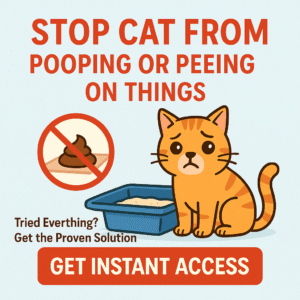If your cat has started peeing on your clothes, furniture, bed, or random household items, you’re likely feeling frustrated and confused. But here’s the truth: your cat isn’t doing it out of spite. When cats pee on things, it’s their way of communicating that something is wrong—physically, emotionally, or environmentally.
Why Is My Cat Peeing on Things?
Your cat may be peeing on things due to a medical issue, stress, territorial behavior, or dissatisfaction with their litter box. Identifying the root cause is the key to stopping the behavior permanently.
The Most Common Reasons Cats Pee on Objects
1. Medical Problems
Health issues are the most important—and urgent—reason to rule out first. When peeing becomes painful or uncontrollable, cats may avoid the litter box altogether.
- Urinary Tract Infection (UTI): Causes painful, frequent urination
- Bladder stones or FLUTD: Leads to urgency and small accidents
- Kidney disease or diabetes: Makes cats urinate more often
- Arthritis: Can make it hard to reach or climb into the box
Solution: Schedule a vet visit immediately. Treating the medical issue often stops the behavior completely.
2. Litter Box Problems
If your cat doesn’t like the litter box, they’ll look for a more comfortable or cleaner spot—like your laundry, sofa, or even a rug.
- Box is dirty or smells too strong
- Type of litter is uncomfortable (too scented, rough, or dusty)
- Box is in a loud or high-traffic location
- Too few litter boxes in a multi-cat home
Fix: Use unscented clumping litter, scoop daily, and provide 1 box per cat plus one extra.
3. Stress or Anxiety
Cats are creatures of habit. Even minor changes to their environment can cause emotional distress and lead to inappropriate urination.
- New baby, pet, or roommate in the house
- Moving to a new home or renovations
- Changes in routine (work hours, meal times, etc.)
- Conflicts with other pets
Fix: Use calming pheromone diffusers, establish routines, and give your cat safe, quiet spaces to retreat.
4. Territorial Marking
Cats often spray or pee on things to mark territory—especially when they feel threatened or want to claim something as “theirs.”
- Unneutered cats are more likely to mark
- Seeing stray cats outside may trigger marking indoors
- Multi-cat households with competition for space
Fix: Neuter or spay your cat, block outdoor views of strange animals, and provide individual resources for each cat.
5. Seeking Attention or Comfort
If your cat is emotionally attached to you, they may pee on your personal items as a form of connection or comfort—especially if you’ve been away or distracted.
- Items like your bed, shoes, or clothes smell like you
- This behavior is more common in anxious cats
Fix: Spend quality time with your cat, provide enrichment (toys, scratching posts), and reward calm behavior.
How to Stop Your Cat from Peeing on Things
Step 1: Visit the Vet
Always start by ruling out medical issues. Your vet may perform a urinalysis, blood test, or ultrasound to detect infections, stones, or metabolic problems.
Step 2: Deep Clean All Soiled Items
- Use enzyme-based cleaners to remove all traces of urine odor
- Never use ammonia-based cleaners—they smell like pee to your cat
- Wash clothes and bedding with vinegar and baking soda
Step 3: Improve the Litter Box Setup
- Have one box per cat, plus one extra
- Use open boxes, not covered ones
- Clean boxes daily and replace litter weekly
- Place boxes in quiet, low-traffic areas
Step 4: Use Natural Deterrents
- Place citrus peels or natural sprays on items your cat pees on
- Cover objects temporarily with foil or plastic until the behavior stops
- Feed your cat near problem areas—cats don’t pee where they eat
Step 5: Retrain Behavior with Cat Spray No More
If the behavior continues despite cleaning and litter box changes, it’s time for a structured behavioral reset. That’s where Cat Spray No More comes in.
Stop the Peeing for Good with Cat Spray No More
Cat Spray No More is a proven, natural training guide that helps you:
- Understand your cat’s emotional and environmental triggers
- Use gentle, effective techniques to redirect behavior
- Prevent future accidents with calming tools and positive reinforcement
- Keep your home clean—and your cat happy
Download Cat Spray No More here and finally break the cycle of inappropriate urination without yelling, sprays, or guesswork.
Quick Reference Table
| Cause | Behavior | Solution |
|---|---|---|
| UTI or bladder problem | Peeing small amounts, licking genitals | Vet treatment + antibiotics |
| Dirty or disliked litter box | Avoiding the box, peeing on soft items | Improve box hygiene and setup |
| Stress or anxiety | Peeing on owner’s belongings | Use calming tools + consistency |
| Territorial marking | Spraying walls, furniture | Spay/neuter + behavior training |
| Habitual behavior | Ongoing peeing on same items | Use Cat Spray No More |
Final Thoughts
Your cat isn’t peeing on things out of revenge—they’re trying to communicate discomfort, illness, or insecurity. With a little detective work, consistent care, and the right tools, you can stop this behavior for good and rebuild trust with your feline friend.
Ready to fix it fast? Get Cat Spray No More now and start enjoying a cleaner, calmer home again.
